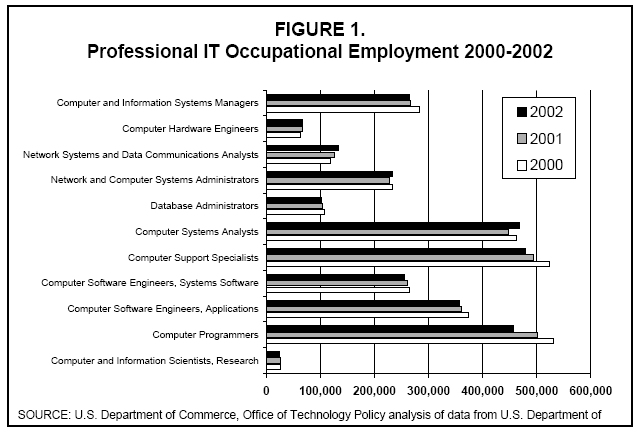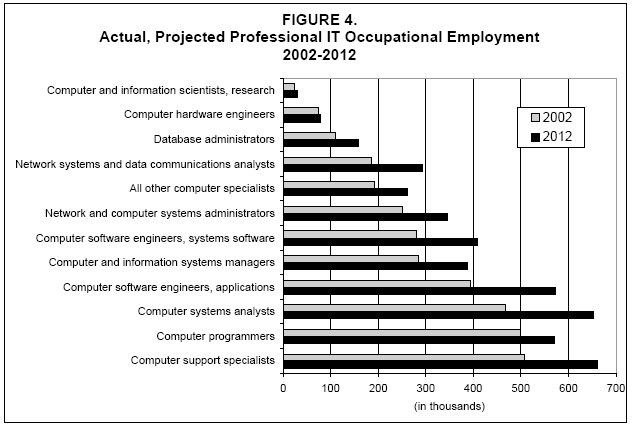THIS IS AN ARCHIVED VERSION OF CRA'S WEBSITE. THIS ARCHIVE IS AVAILABLE TO PROVIDE HISTORICAL CONTENT.
PLEASE VISIT HTTP://WWW.CRA.ORG FOR THE LATEST INFORMATION
| About CRA |
| Membership |
| CRA for Students |
| CRA for Faculty |
| CRA-Women |
| Computing Community Consortium (CCC) |
| Awards |
| Projects |
| Events |
| Jobs |
| Government Affairs |
| Computing Research Policy Blog |
| Publications |
| Data & Resources |
| CRA Bulletin |
| What's New |
| Contact |
| Home |
<< Back to May 2004 CRN Table of Contents
[Published originally in the May 2004 edition of Computing Research News, Vol. 16/No. 3, pp. 1, 21.]
An Overview of Past and Projected Employment Changes in the Professional IT Occupations
By John Sargent
Professional information technology (IT) occupations have experienced both rapid growth and, most recently, higher-than-average job losses.
Professional IT occupations provided the lion’s share of science and engineering job growth during the period 1991-2001. Computer system analysts and scientists and computer programmers together accounted for 79.4 percent of job growth in the science and engineering occupations during this period; if one also adds electrical/electronic engineers (many of whom are IT professionals), the total rises to 93.1 percent.[1]
Given the substantial role that professional IT occupations have played in high-wage job creation—directly and indirectly—and their importance to U.S. competitiveness, economic growth, and innovation, policymakers have focused attention on understanding this key labor market and the challenges associated with both rapid job growth and recent job losses in these occupations.
Accordingly, since the mid-1990s the U.S. Department of Commerce’s Office of Technology Policy (OTP) has conducted extensive analysis of the characteristics of the IT workforce, the dynamics of the IT labor market, the IT education and training landscape, and potential policy implications.[2] This article presents an overview of OTP’s analysis of IT occupational employment changes between 1990 and 2002, as well as OTP’s analysis of the Department of Labor’s Bureau of Labor Statistics’ (BLS) projections for IT occupational growth through 2012. IT occupational growth/loss analyses for the 1990 to 2002 period discussed in this article are based on data from two sources: 1) the Current Population Survey (CPS), a product of the U.S. Department of Commerce’s Census Bureau and BLS, and 2) the Occupational Employment Statistics (OES) survey, a BLS product.
These surveys used separate and distinct occupational classifications. In addition, the survey methodologies differ significantly; for example, CPS data are acquired through a survey of households, while OES data are derived from a survey of companies. As a result, the CPS and OES surveys arrive at different aggregate numbers for the IT workforce and thus are not directly comparable. Still, both surveys provide insight into the dynamics of the labor market for professional IT workers.
A Decade of Strong Employment Growth
Rapid advances in digital technologies and their widespread deployment throughout the economy fueled explosive growth in the demand for workers skilled in the development and use of information technology. Between 1990 and 2000, CPS data show that the number of jobs in professional-level IT occupations doubled, expanding from 1.2 million to 2.5 million. This translates into an annual growth rate [3] of 7.2 percent for these IT occupations, compared with 1.3 percent for all occupations during the same period.
Recent Losses in IT Occupational Employment
The IT occupational employment picture has been quite different since 2000. Between 2000 and 2002, OES data show that employment in the professional IT occupations fell 5.0 percent, significantly higher than total U.S. employment which fell only 1.7 percent. A variety of factors are likely to have contributed to these job losses in the IT occupations, including: the dot-com bust; the end of work on Y2K; the terrorist attacks of September 11, 2001 and their related effect on the U.S. economy; a downturn in corporate IT spending; the brief 2001 recession; productivity increases; and the offshore outsourcing (offshoring) of IT work. The effect each of these factors had on the recent drop in the aggregate number of professional IT workers in the United States remains uncertain.
Also, the decline was not uniform across professional IT occupations during this period. Some IT occupations grew—computer systems analysts (1.0 percent), network systems and data communications analysts (11.9 percent), and computer hardware engineers (5.5 percent). Network and computer systems administrators declined only slightly (0.6 percent). And other IT occupations experienced larger declines—computer programmers (13.8 percent) and computer support specialists (8.4 percent) (see Figure 1).

At the same time, CPS data show that unemployment rates in the IT occupations reached all-time highs in 2002—6.1 percent for computer programmers, and 5.0 percent for computer system analysts and scientists.
Interestingly, during the 2000-2002 period, every professional IT occupation enjoyed positive salary growth ranging from 2.2 percent on the low end (computer programmers) to 6.2 percent on the high end (computer and information systems managers).
Projected Return to IT Employment Growth, But Slower Than in the 1990s
Every two years, BLS develops occupational employment projections covering a ten-year period. In BLS’s latest projections—released in February 2003, covering the period 2002-2012—IT employment growth is projected to resume, though at a slower rate than during the 1990-2000 period. Overall, employment in the professional IT occupations [4] is expected to grow from 3.3 million to 4.4 million, adding a total of 1.15 million new jobs. This represents a projected annual growth rate of 3.1 percent, more than twice that of the overall U.S. annual job growth of 1.4 percent. BLS projects a total of 1.6 million job openings [5] for the professional IT occupations during the ten-year period.
As in previous BLS projections, the projected growth rate, new jobs, and total job openings [6] for the professional IT occupations far surpass those projected for the engineering, physical sciences, life sciences, and mathematical occupations (see Table 1).

However, the BLS projections for 2002-2012 represent a decreased expectation for employment growth in the professional IT occupations compared with the agency’s 2000-2010 projections. In its 2000-2010 projections, BLS projected 2.15 million new jobs in the professional IT occupations. In contrast, BLS projects that only 1.15 million new IT jobs will be created during the 2002-2012 period, a reduction in projected job growth of nearly one-half (see Figure 2).

Despite these reduced expectations, professional IT occupational growth is still projected to account for the lion’s share (70 percent) of science and engineering job openings during the period 2002-2012 (see Figure 3).

Projected growth among the IT occupations varies significantly. On the low end of job growth, computer hardware engineers are expected to grow at an annual rate of 0.5 percent. Computer programmers are expected to grow at an annual rate of 1.4 percent, equal to the overall annual job growth rate of the United States during this period. All other IT occupations are projected to grow at an annual rate of 2.7 percent or higher—nearly twice the national average—led by network systems and data communications analysts, a category that is expected to grow at a rate of 4.6 percent. Three other IT occupations—computer software engineers (applications), computer software engineers (systems software), and database administrators—are expected to grow at an annual rate of 3.8 percent.
Growth in the number of jobs in the professional IT occupations is projected to be led by computer systems analysts (185,000), followed by computer software engineers (applications) (179,000) and computer support specialists (153,000). Computer hardware engineers (4,000) and computer and information systems managers (7,000) are expected to add the fewest jobs.

Endnotes:
[1] Current Population Survey.
[2] “The Digital Work Force: Building Infotech Skills at the Speed of Innovation,” U.S. Department of Commerce, June 1999; “Education and Training for the Information Technology Workforce: Report to Congress from the Secretary of Commerce,” U.S. Department of Commerce, June 2003.
[3] In this article, annual growth rates are actually calculated compounded annual growth rates over the identified period.
[4] The Department of Commerce’s Office of Technology Policy defines professional IT occupations as including: computer and information systems managers; computer and information scientists, research; computer hardware engineers; computer programmers; computer software engineers, applications; computer software engineers, systems software; computer support specialists; computer systems analysts; database administrators; network and computer systems administrators; network systems and data communications analysts; and all other computer specialists.
[5] Total job openings refers to the sum of job growth plus net replacement requirements.
[6] Total job openings includes both job growth and net replacements.
John Sargent is a Senior Policy Analyst in the Office of Technology Policy, U.S. Department of Commerce.
Copyright © 2007 Computing Research Association. All Rights Reserved. Questions? E-mail: webmaster@cra.org.
